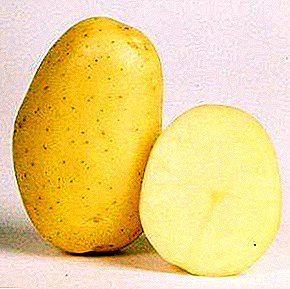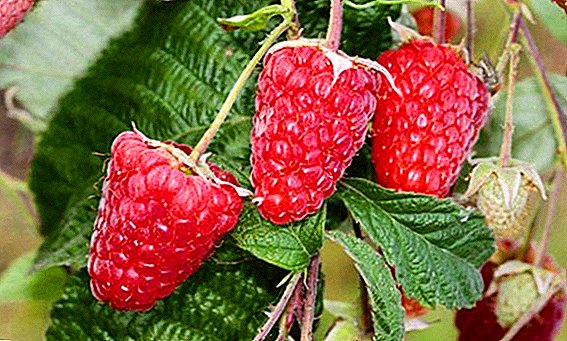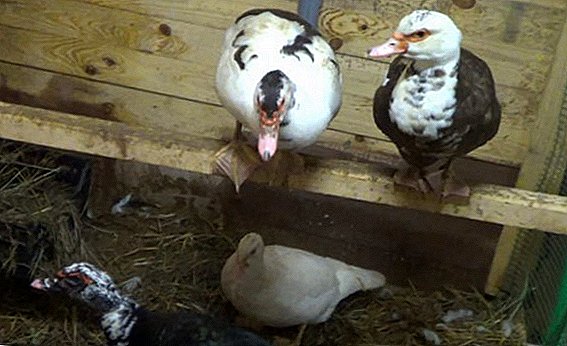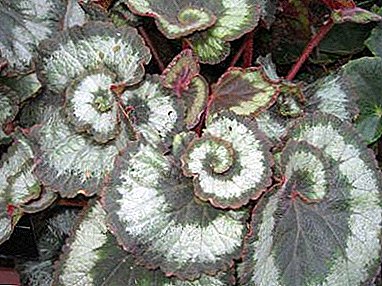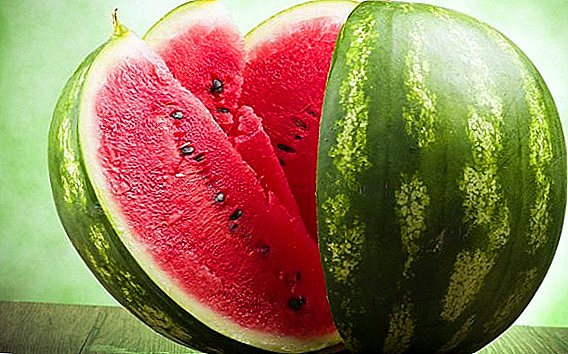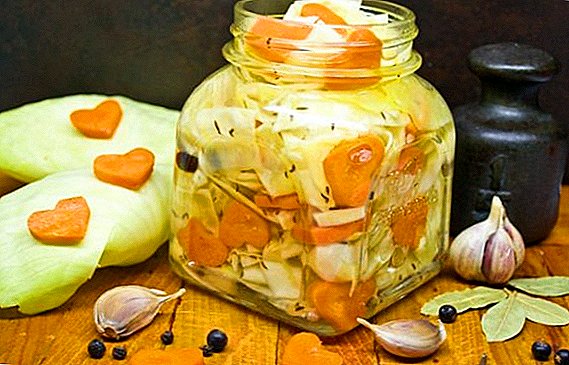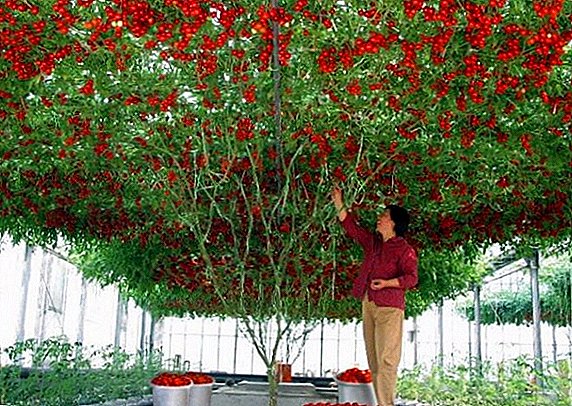
New Zealand spinach is a related crop of ordinary spinach and has an enriched mineral and vitamin composition. It will be useful for both adults and children, and its stunning taste will appeal to even the most sophisticated gourmets.
Having been widely spread among gardeners and gardeners, New Zealand spinach was used in cooking as an available source of nutrients in a fresh and thermally processed form. Learn all about this spinach and learn how to grow it right in your garden. Those who do not have a plot do not need to be upset. Spinach can be grown even on the windowsill.
Botanical description
 New Zealand Spinach - annual early ripening vegetables from the family of crystal, genus Tetragonia.
New Zealand Spinach - annual early ripening vegetables from the family of crystal, genus Tetragonia.
Seed germination of New Zealand spinach is as much as 98%, and the yield is up to 3-5 kilograms per square meter. The plant is warm and moisture-loving. Shooting later. The plentiful constant gain of greens is characteristic.
Suitable for growing on open ground, in greenhouse and home conditions. The plant does not tolerate cold (less than 15 degrees Celsius), strong winds and short frosts. Growth period is 55-65 days, transplanting occurs 1 month after sowing.
Appearance Description
Fruits are small, have the form of an armored seed box with spikes, contain from 2 to 8 seeds. The root system is shallow, moderately developed, branched. The greens are fleshy, juicy, characterized by rapid growth as they are cut. All parts of the plant have a faint characteristic aroma.
Story
At the end of the 18th century, in 1779, the species was discovered in New Zealand. Good taste contributed to the popularization of the plant, after 2 years the seeds of this spinach came to England, from where they spread throughout Europe. In England, New Zealand spinach was grown for a long time in greenhouse conditions, until at the end of the 19th century it was not revealed that the plant was suitable for growth in open ground.
The plant got to Russia in the middle of the 20th centurywhere it quickly spread throughout the central part due to high yields and rapid growth.
Chemical composition and beneficial properties
- Calorie content - 23 Kcal per 100 grams.
 Chemical composition. Proteins - 4 g, fats - 0.3 g, carbohydrates - 3 g, fiber - 2.5 g, water - 90 g per 100 grams of product.
Chemical composition. Proteins - 4 g, fats - 0.3 g, carbohydrates - 3 g, fiber - 2.5 g, water - 90 g per 100 grams of product.- Trace elements and vitamins. Retinol - 85 mg, B1 - 6.7 mg, B2 - 14 mg, B5 - 6 mg, B6 - 4 mg, B9 - 5 mg, B12 - 20 mg, calciferol - 60 mg, Tocopherol - 18 mg, Vitamin K - 0.1 mg , Choline - 15 mg, Vitamin PP - 5 mg, calcium - 31 mg, Sodium - 20 mg, Selenium - 2 mg, Chlorine - 10 mg, Iodine - 75 μg, Manganese - 45mg, Copper - 1 mg, Selenium - 1.8 mg , Iron -15 mcg, Zinc - 4.4 mg.
Properties of New Zealand Spinach:
- Vitamins of group B involved in the transmission of nerve impulses.
- Retinol and carotenoids - normalize the work of the retina and optic nerves.
- Secretin - simulates the production of digestive enzymes.
- Iodine - regulates the thyroid gland, the growth of bones and cartilage.
- Calcium contributes to the proper development of teeth, bones and blood vessels.
- Vitamin E has an antioxidant effect.
- Iron participates in the creation of hemoglobin and prevents the occurrence of anemia.
Contraindications
- Gastritis and peptic ulcer in the period of exacerbation.
- Rheumatism and other autoimmune diseases.
- Hypertonic disease.
- Exacerbation of kidney or liver disease.
Using
New Zealand spinach is used in the preparation of first and second courses, vegetable salads, vegetarian and meat soups, juices, omelettes and pastries.
This type is used fresh, boiled, steamed, frozen, dried. Has a good keeping quality and a longer shelf life compared to other varieties.
Does the taste differ from the usual?
Since New Zealand Spinach contains less oxalic acid, it has a delicate, juicy and less sour taste.
Growing on the garden
Selection and preparation of the site
 Spinach soil should be well lit and drained., rather friable, moisture-absorbing and fertile. A small amount of clay or sand is allowed. The soil is prepared in the fall.
Spinach soil should be well lit and drained., rather friable, moisture-absorbing and fertile. A small amount of clay or sand is allowed. The soil is prepared in the fall.
They dig up the soil at a depth of 20-25 centimeters, bring in compost at the rate of 1 bucket per square meter, fertilize with superphosphate or lime. In the spring before sowing, 10 grams of ammonium nitrate or urea are introduced into the soil. This is necessary in order to better grow spinach and get all the necessary substances for life.
Seed preparation and sowing
Before sowing, seeds are soaked in warm water for 30-48 hours, changing water every 8 hours. Landing time: middle or end of April.
Scheme
Seeds are sown at a distance of 35-40 cm to a depth of 1-2 centimeters. Allowed planting of the whole seed box, followed by thinning. A large distance between the seeds is necessary for the free growth of the stems. Between the rows leave a distance of at least 50 centimeters. Seeds germinate slowly at a temperature of 15-23 degrees, within 2-3 weeks after sowing.
Landing time in open ground
For seedlings, seeds are sown in 8 × 8 centimeters pots. Landing time is mid-April. In one pot, place three seeds or a seed box to a depth of 2 cm. After the emergence of seedlings, weaker shoots are removed. The soil in the pot should be maintained in a moist warm condition that will contribute to the rapid emergence of shoots.
The time of landing in open ground corresponds to the end of May or the beginning of July (when all frosts have passed). Seedlings should be at least 10 centimeters in height.
Scheme: in a bed 1 meter wide, seedlings are planted in 2 rows at a distance of 35-40 centimeters to the same depth in which they were in pots.
Growing at home
 When landing at home there are the following features:
When landing at home there are the following features:
- Early landing is possible, in the middle or end of March.
- For planting choose the southeast or southwest when illuminated for at least 9 hours a day.
- Planting is possible both in pots and in wooden boxes with a height of at least 10, but not more than 15 centimeters (for good root placement).
- The soil is kept wet. Preferably use ready-made primer.
Care activities
- Temperature. The optimum temperature for growth is 22-25 degrees during the day, and at least 15 at night.
- Watering and moisture. Watering plentiful, every other day, is allowed every day at low humidity. Optimum air humidity - 50-60%. Watering is carried out in the morning or at sunset, without falling on the foliage and flowers of the plant.
- Priming. The soil is kept loose, drained, slightly acidic or neutral. The soil should be constantly moist, but without a crust on the surface.
- Lighting. Light day should be at least 9 hours a day, with a lack of lighting using fluorescent lamps.
- Top dressing. For New Zealand spinach choose phosphate, nitrogen and potassium fertilizers, wood ash, possibly nitrophosphate fertilizer. Fertilizers are carried out at least two times - during the period of emergence and flowering at the rate of 50 grams of finished fertilizer per square meter.
- Thinning. With the emergence of shoots, thinning is carried out at 10-15 centimeters, if the seeds were sown close to each other. When 5 true leaves appear, the plants are thinned to 30-40 centimeters.
Loosening is carried out after each watering.
Harvesting
Harvesting is carried out repeatedly, at least 1 times a week since the appearance of sheets of a length of 4 centimeters. Suitable for collecting leaves are elastic, have a rich green color. Hard leaves are old, they are not eaten.
The collection of leaves is carried out even when they are not planned to be used, because the foliage quickly becomes rigid, and with rare pruning stops growing. Harvesting is carried out from the end of June to the first autumn frosts.
Where to buy planting material and what to look for when buying?
 Seeds can be purchased at garden stores or ordered online.x Seedlings of plants can be purchased from gardeners or in gardening stores.
Seeds can be purchased at garden stores or ordered online.x Seedlings of plants can be purchased from gardeners or in gardening stores.
When buying, pay attention to the appearance of the seeds - they should be rounded, the same size, light brown in color.
Seedlings should be bright green, free from damage.Stems low, moderately branched root system.
The price for 2 grams of seeds ranges from 9 to 18 rubles and averages 13.5 rubles. To get a healthy and strong plant, seeds can be harvested from your crop. Such seeds sprout better, and the seedlings of them get stronger.
Diseases and pests
The most common spinach pests are:
- root fusarium rot;
- anthracnose;
- miner fly;
- viral mosaic;
- chalcosporosis;
- gray rot;
- mealy fly;
- Medvedka.
To protect spinach follow the rules of crop rotation and plant care.
New Zealand Spinach - precocious culture with a decorative appearance and a large set of essential biologically active substances. Simple rules of cultivation and care allow you to get a constant fresh crop of vegetables, suitable for use in any form. Vitamins and microelements of New Zealand spinach increase immunity, effectively prevent anemia and endocrine gland diseases.


 Chemical composition. Proteins - 4 g, fats - 0.3 g, carbohydrates - 3 g, fiber - 2.5 g, water - 90 g per 100 grams of product.
Chemical composition. Proteins - 4 g, fats - 0.3 g, carbohydrates - 3 g, fiber - 2.5 g, water - 90 g per 100 grams of product.